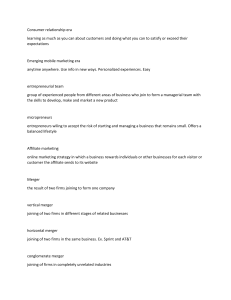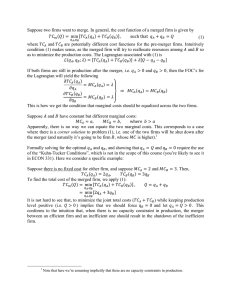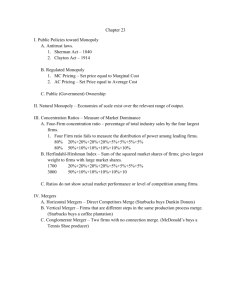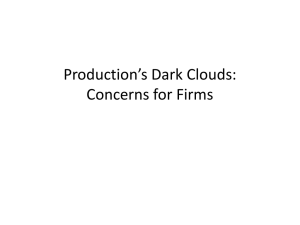File
advertisement
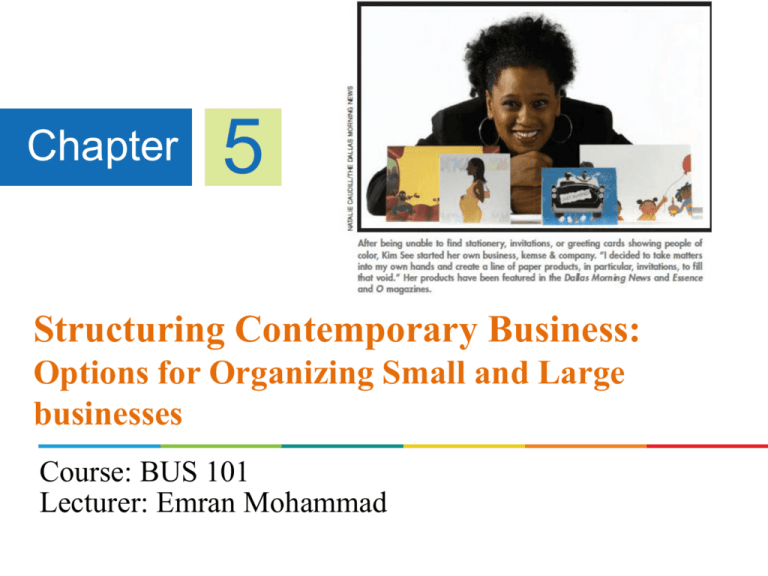
Chapter 5 Structuring Contemporary Business: Options for Organizing Small and Large businesses Course: BUS 101 Lecturer: Emran Mohammad What is Small Business • small business is a firm that is independently owned and operated, is not dominant in its field, and meets industry specific size standards for income or number of employees. Contribution of Small business to the Economy 1. Creating new jobs: on average three of every four new jobs are created by companies with fewer than 500 employees. 2. Creating new industries: Google, Amazon, Face book 3. Innovation: Netflix.com Why small business fail 1. Management Shortcomings – Fail to recruit specialized or expert personnel due to finance shortage – Underestimating marketing or management department compared to finance department or legal attorneys – Founders of new businesses are typically excited about the potential of newly designed products, so they may neglect important details such as marketing research to determine whether potential customers share their excitement. Why small business fail (cont) 2. Inadequate Financing: – First-time business owners often assume – that their firms will generate enough funds – from the first month’s sales to finance continuing operations. Building a business takes time, though. Employees must be trained, equipment purchased, deposits paid for rent and utilities, and marketing dollars spent to inform potential customers about the new firm and its product offerings. – Uneven cash flows during the year in different seasons – Rely less on debt for financing than large businesses Why small business fail (cont) 3. Government Regulation: -Paperwork expense and complication: • Difficult to bear the costs of government paperwork because of their limited staff and budgets. • Can’t hire specialized personnel for paper work, so the process becomes lengthy and complicated -Taxes: •In addition to local, state, and federal income taxes, employers must pay taxes covering workers’ compensation insurance, Social Security payments, and unemployment benefits. Increasing the likelihood of small business success • Develop a business plan • Use the resources provided by – Small Business Administration – Local business incubators – and other sources for advice, funding, and networking opportunities. Creating a Business Plan • business plan: written document that provides an orderly statement of a company’s goals, the methods by which it intends to achieve those goals, and the standards by which it will measure achievements. Creating a Business Plan (cont.) • Contents of a business plan: – An executive summary that briefly answers the who, what, why, when, where, and how questions for the business – An introduction that includes a general statement of the concept, purpose, and objectives of the proposed business – Separate financial and marketing sections – Résumés of principals—especially in plans written to obtain financing Use the Resources • Small Business Administration (SBA): federal agency that aids small businesses by providing management training and consulting, financial assistance, and support in securing government contracts. • Business incubator: organization that provides temporary low cost, shared facilities to small start-up ventures. e.g: BizCube Use the Resources Small Business Investment Companies (SBICs): These are SBA-licensed organizations run by experienced venture capitalists. SBICs use their own capital, supplemented with government loans, to invest in small businesses. Like banks, SBICs are profit-making enterprises, but they are likely to be more flexible than banks in their lending decisions. Alternatives for Organizing a business Corporate Management When businesses join forces 1. Merger: combination of two or more firms to form one company. – A vertical merger combines firms operating at different levels in the production and marketing process— the combination of a manufacturer and a large retailer. – A horizontal merger joins firms in the same industry that wish to diversify, increase their customer bases, cut costs, or offer expanded product lines – A conglomerate merger combines unrelated firms. When businesses join forces (cont) 2. Acquisition: procedure in which one firm purchases the property and assumes the obligations of another. 3. Joint venture: a commercial enterprise undertaken jointly by two or more parties which otherwise retain their distinct identities. Acquired Source: http://www.bbc.com/news/busin ess-21769507 http://www.independent.co.uk/n ews/business/news/tesco-signssupermarket-joint-venture-inchina-9453455.html
